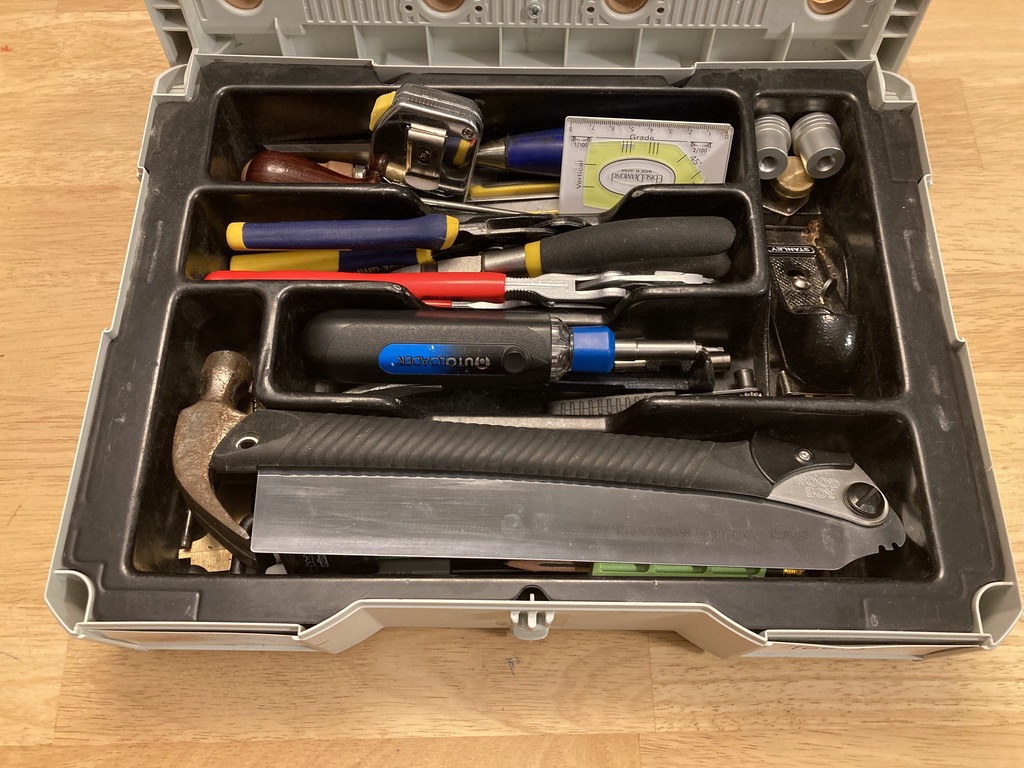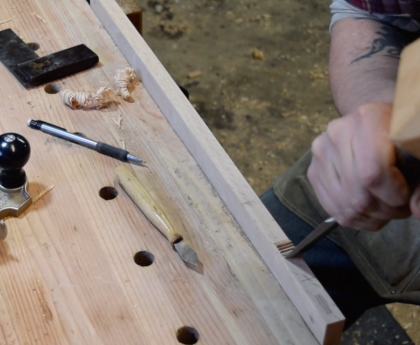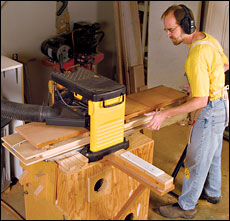I have a carefully-chosen group of manual hand tools that lives in a MFT Systainer toolbox that covers my particular needs for the majority of general tasks. It is always with me whether I’m working in the shop, on site, or around the house.
Every once in a while, I vacuum out all the wood chips and sawdust and review the contents of my Hand Tools kit, making adjustments to increase its utility. Over the holidays, I did just that. Here they are in storage.

Here are the same tools unpacked for examination. Many of the tools can be easily identified, but I will name each one and briefly describe its use to me.

- Tug-N-Back pencil holder – for jobs involving walking around a lot, this ensures that a pencil is always within reach, saving a lot of time looking for it. There is a steel clip on the back that I usually clip to the front collar of my shirt under my chin. It works like a retractable power cord – pull and release to extend, pull and release to retract;
- Awl – used mostly for marking hole locations and starting screws. Occasionally it’s used to scribe a line, mostly on non-wood surfaces;
- Simple Scribe with pencil – this pencil holder with multiple offsets allows parallel lines to be drawn quickly and consistently. While it doesn’t get a ton of use, it doesn’t take up much space either;
- Standard Sharpie permanent marker – great for labelling the backside or underside of components that will be installed, writing on plastic parts bags and more;
- Church key – for opening cans of paint and occasionally as a slim, light-duty pry bar;
- Pair of TSO DoubleGroove Small Bench Dogs – these fit into the holes in the lid of the MFT Systainer and help immobilize workpieces on the lid of the toolbox;
- Four-inch brass caliper – this caliper is large and accurate enough for sizing parts and hardware, but small and rugged enough to toss it in the toolbox without a bulky case. This one is easier to read than the all-brass versions commonly available;
- Ten-foot x 1/2 inch tape measure – this tape fits well in the toolbox and is long enough for most measuring tasks. My favourite 10 foot tape measure is a Stanley Leverlock, but I only have two of those that live in the shop at the bench and table saw where they are used constantly;
- High-leverage flush-cut side cutters – useful for cutting staples, nails, plastic, and more;
- Ten-inch Knipex Pliers Wrench – an amazing tool, its lower sliding jaw remains parallel to the fixed jaw, and the spring-loaded button allows the maximum tool opening to be set up to 2 inches. The tool is incredibly fast and easy to operate;
- Eight-inch ViseGrip adjustable pliers – unlike some adjustable pliers, these adjust with a press of the spring loaded button, so they only adjust when you want. Unlike the Knipex Pliers Wrench, the lower jaw pivots and the jaws are serrated, so they don’t have as delicate of a touch;
- Twelve-in-1 tool – a handy tool consisting of two 6 inch rules held together with a threaded fastener. The most useful functions are: rule, T-square, marking gauge, bevel gauge, angle transfer tool and depth gauge;
- Eight-inch cat’s paw – a compact and sturdy pry bar with a thin, wide pry surface at one end that is great for lifting and prying. The other end features a nail puller and flat surface for driving nails;
- Fine tip Sharpie permanent marker – useful for making layout lines and labelling parts on their backside for orientation or location;
- HB pencil – useful for fine general marking;
- Carpenter’s pencil – useful for coarse general marking with less risk of breaking the lead and less frequent need for sharpening than a regular pencil;
- Carpenter’s pencil – a second one that lives in the Tug-N-Back pencil holder;
- Spear point marking knife – this one was made from an old chisel. The long blade allows use in almost any situation. (Some may say that using a marking knife in renovations is unnecessary, but then so are air nailers.);
- Snap-off utility knife – a cheap, lightweight plastic-handled knife for general cutting and scoring tasks, and sharpening carpenter’s pencils;
- Pocket level – ideal for levelling tasks that don’t warrant a larger level and does the job way better than a smartphone. The metric scale is a useful bonus, too. The back is blank… I guess I should find something to make use of that real estate.
- Pointed nail set – useful for setting finishing nails;
- Concave nail set – useful for setting pins and brads, and starting removal of door hinge pins;
- Irwin Blue Chip 3/4 inch chisel – handy for trimming, chopping, and other chisel work. Not ever used as a pry;
- Ten ounce claw hammer – a recent addition on a trial basis, it may be used for driving and pulling nails, physical adjustments, and closing paint cans with a scrap of wood to distribute the force of the blow;
- Compact ratcheting screwdriver – useful for applying loads of torque, but mostly for getting into tight spaces;
- Autoloader multi-bit screwdriver – this multi-bit screwdriver uses standard 1/4 inch x 1 inch screwdriver bits that also work well with the other screwdriving accessories in this kit;
- Veritas Screw Lifter – handy for applying steady upwards pressure when removing the odd screw from a stripped hole;
- Pencil sharpener – useful for sharpening pencils and chamfering small dowels;
- Stanley low angle block plane – indispensible for trimming and chamfering edges;
- Silky Woodboy folding saw – ideal for making fast and clean crosscuts in wood, as well as plastics and other soft materials. The blade is taper ground, so clearance can be had without any set on the teeth, allowing it to be used flat against any surface without causing scratches;
- Tilting bit holder – used in conjunction with the Autoloader screwdriver or a cordless drill, this accessory allows screws to be driven adjacent to an obstruction such as a wall; and
- Slim saw – made from an old hacksaw blade with good working teeth at one end and the rest of the teeth removed, this slim saw gets into spaces no other saw can.

How many of these tools are in your toolkit? Are any of these on your wishlist?




